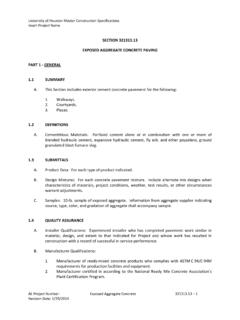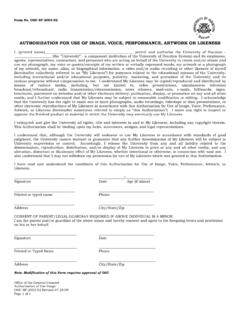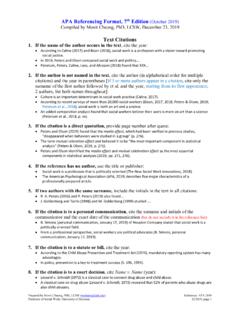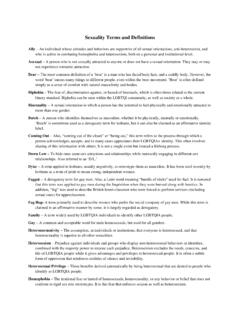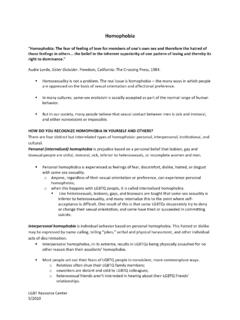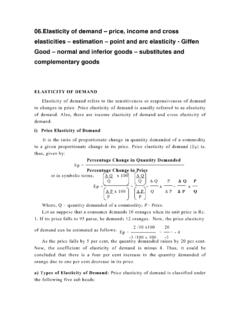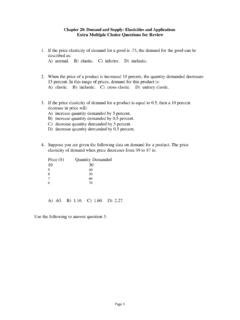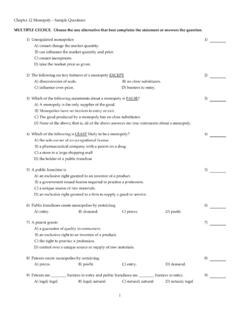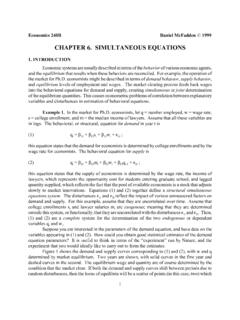Transcription of CHAPTER 2 THE BASICS OF SUPPLY AND DEMAND
1 CHAPTER 2: The BASICS of SUPPLY and DEMAND 5 CHAPTER 2 THE BASICS OF SUPPLY AND DEMAND EXERCISES 1. Consider a competitive market for which the quantities demanded and supplied (per year) at various prices are given as follows: Price ($) DEMAND (millions) SUPPLY (millions) 60 22 14 80 20 16 100 18 18 120 16 20 a. Calculate the price elasticity of DEMAND when the price is $80. When the price is $100. We know that the price elasticity of DEMAND may be calculated using equation from the text: EQQPPPQQPDDDDD== . With each price increase of $20, the quantity demanded decreases by 2.
2 Therefore, QD P = 220= At P = 80, quantity demanded equals 20 and ED=8020 ()= Similarly, at P = 100, quantity demanded equals 18 and ED=10018 ()= b. Calculate the price elasticity of SUPPLY when the price is $80. When the price is $100. The elasticity of SUPPLY is given by: EQQPPPQQPSSSSS== . With each price increase of $20, quantity supplied increases by 2. Therefore, QS P =220= At P = 80, quantity supplied equals 16 and CHAPTER 2: The BASICS of SUPPLY and DEMAND 6ES=8016 ()= Similarly, at P = 100, quantity supplied equals 18 and ES=10018 ()= c.
3 What are the equilibrium price and quantity? The equilibrium price and quantity are found where the quantity supplied equals the quantity demanded at the same price. As we see from the table, the equilibrium price is $100 and the equilibrium quantity is 18 million. d. Suppose the government sets a price ceiling of $80. Will there be a shortage, and, if so, how large will it be? With a price ceiling of $80, consumers would like to buy 20 million, but producers will SUPPLY only 16 million. This will result in a shortage of 4 million. 2. Refer to Example on the market for wheat.
4 At the end of 1998, both Brazil and Indonesia opened their wheat markets to farmers. (Source: ) Suppose that these new markets add 200 million bushels to wheat DEMAND . What will be the free market price of wheat and what quantity will be produced and sold by farmers in this case? The following equations describe the market for wheat in 1998: QS = 1944 + 207P and QD = 3244 - 283P. If Brazil and Indonesia add an additional 200 million bushels of wheat to wheat DEMAND , the new DEMAND curve QD , would be equal to QD + 200, or QD = (3244 - 283P) + 200 = 3444 - 283P.
5 Equating SUPPLY and the new DEMAND , we may determine the new equilibrium price, 1944 + 207P = 3444 - 283P, or 490P = 1500, or P* = $ per bushel. To find the equilibrium quantity, substitute the price into either the SUPPLY or DEMAND equation, , QS = 1944 + (207)( ) = 2, and QD = 3444 - (283)( ) = 2, 3. A vegetable fiber is traded in a competitive world market, and the world price is $9 per pound. Unlimited quantities are available for import into the United States at this price. The domestic SUPPLY and DEMAND for various price levels are shown below. Price SUPPLY DEMAND (million lbs.)
6 (million lbs.) 3 2 34 6 4 28 9 6 22 12 8 16 15 10 10 CHAPTER 2: The BASICS of SUPPLY and DEMAND 718 12 4 a. What is the equation for DEMAND ? What is the equation for SUPPLY ? The equation for DEMAND is of the form Q=a-bP. First find the slope which is Q P= 63= 2= b. You can figure this out by noticing that every time price increases by 3 quantity demanded falls by 6 million pounds. DEMAND is now Q=a-2P. To find a, plug in any of the price quantity demanded points from the table: Q=34=a-2*3 so that a=40 and DEMAND is Q=40-2P. The equation for SUPPLY is of the form Q=c+dP.
7 First find the slope which is Q P=23. You can figure this out by noticing that every time price increases by 3 quantity supplied increases by 2 million pounds. SUPPLY is now Q=c+23P. To find c plug in any of the price quantity supplied points from the table: Q=2=c+23(3) so that c=0 and SUPPLY is Q=23P. b. At a price of $9, what is the price elasticity of DEMAND ? At a price of $12? elasticity of DEMAND at P=9 is PQ Q P=922( 2)= 1822= elasticity of DEMAND at P=12 is PQ Q P=1216( 2)= 2416= c. What is the price elasticity of SUPPLY at $9? At $12?
8 elasticity of SUPPLY at P=9 is PQ Q P=9623 =1818= elasticity of SUPPLY at P=12 is PQ Q P=12823 =2424= d. In a free market, what will be the price and level of fiber imports? With no restrictions on trade, world price will be the price in the United States, so that P=$9. At this price, the domestic SUPPLY is 6 million lbs, while the domestic DEMAND is 22 million lbs. Imports make up the difference and are 16 million lbs. 4. The rent control agency of New York City has found that aggregate DEMAND is QD = 100 - 5P. Quantity is measured in tens of thousands of apartments.
9 Price, the average monthly rental rate, is measured in hundreds of dollars. The agency also noted that the increase in Q at lower P results from more three-person families coming into the city from Long Island and demanding apartments. The city s board of realtors acknowledges that this is a good DEMAND estimate and has shown that SUPPLY is QS = 50 + 5P. a. If both the agency and the board are right about DEMAND and SUPPLY , what is the free market price? What is the change in city population if the agency sets a maximum average monthly rental of $100, and all those who cannot find an apartment leave the city?
10 CHAPTER 2: The BASICS of SUPPLY and DEMAND 8To find the free market price for apartments, set SUPPLY equal to DEMAND : 100 - 5P = 50 + 5P, or P = $500, since price is measured in hundreds of dollars. Substituting the equilibrium price into either the DEMAND or SUPPLY equation to determine the equilibrium quantity: QD = 100 - (5)(5) = 75 and QS = 50 + (5)(5) = 75. We find that at the rental rate of $500, 750,000 apartments are rented. If the rent control agency sets the rental rate at $100, the quantity supplied would then be 550,000 (QS = 50 + (5)(1) = 55), a decrease of 200,000 apartments from the free market equilibrium.
